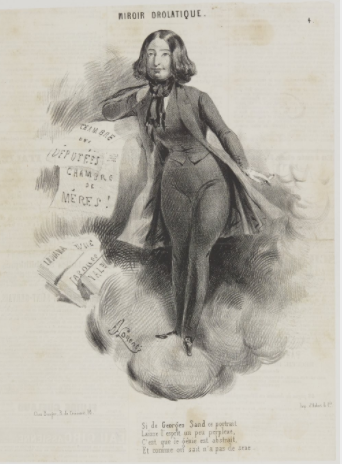PG Showcase: James Illingworth on George Sand

The Mythopoetics of Bodily Representation in George Sand
My research, funded by the AHRC Northern Bridge Doctoral Training Partnership, considers the representation of the body in nineteenth-century fiction, focusing on the works of George Sand (1804-76). The 1800s witnessed major developments in science and medicine, contributing to greater levels of understanding of the human body, but under the decrees of the Napoleonic Code the female body suffered alarming levels of control. The Code stripped women of what legal rights they had previously obtained, to the point where women legally possessed fewer rights than children, finding themselves legally subservient to their significant male others. In this context of decorum and subservience Sand stands out. She left her aristocratic husband to become a writer in Paris free from the bonds of marriage, wore male dress in public, and adopted a deliberately androgynous pseudonym. Much attention has been paid to Sand as a figure, to her own body, itself frequently considered a site of rebellion; my study seeks to understand how this translates into her literary output, how the bodies she depicts in her novels perform similar subversive acts.
Bodies are a particular object of fascination for nineteenth-century literature, but representations of women tended to fall back onto stereotypes enshrined in myth. Sand’s vast and diverse output has been considered as providing a thoroughly modern conception of gender by nineteenth-century standards, and my research seeks to understand how Sand uses the form of the novel in particular to disrupt the dominant method of representing bodies in French texts of the time: realism. My thesis argues that Sand’s alternative model of writing, which has often been described as ‘idealist’, subverts the status quo through a particular kind of symbolism, one I am calling Sand’s ‘mythopoetics’. Sand’s writings take myths of the body that recur in the literature of her age (Eve, the Androgyne, Pygmalion, Narcissus) and subverts them, whilst simultaneously writing texts that at times appear realist but similarly destabilise this particularly male mode of writing.
My work therefore weaves together ideas of gender, social history and science to provide a new reading of a writer whose significance rests on her uniqueness. By prevailing against the myth that Sand wrote without thought and instead suggesting that her literary output had an overarching design, my thesis revalorises Sand as a figure who was in many ways ahead of her time, and considers how literature can be used in multiple ways to promote social change.
James Illingworth, Queen’s University Belfast
Image: ‘Miroir drolatique de George Sand’, Alcide-Joseph Lorentz, 1842, Gallica.fr
